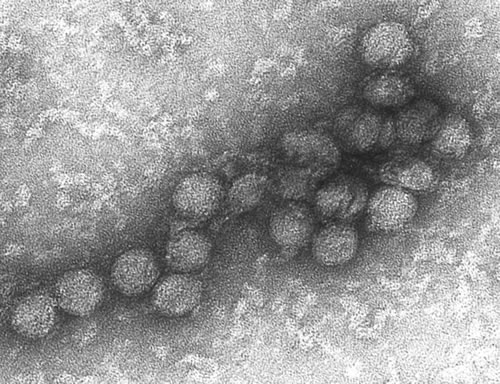Viral Infections
Background
Tick-borne encephalitis [en-sef-e-li-tis] (TBE) is a Flavivirus that has spread from central to north-west Europe. It is closely related to Russian spring-summer encephalitis (RSSE) and Louping-ill. The virus can be transmitted both transovarially (from the female tick through the egg to the next generation) and transstadially (through each stage of the tick’s life cycle). Infection may also occur following the consumption of raw milk from goats, sheep or cows. Transmission from an infected mother to her foetus can also occur.
 Flavivirus
Flavivirus
As of mid 2006, no cases have been reported to the UK’s Health Protection Agency (HPA), although it is possible that there may have been cases which have not been reported or recognised.
2019 brings evidence that tick-borne encephalitis (TBE) has been found to exist in the UK.
Signs & Symptoms
The period of incubation of TBE is usually 6-14 days and is asymptomatic. Shorter incubation periods have been reported after milk-borne exposure. Initial symptoms lasting for 2-4 days are of fever, headache, nausea and/or vomiting and common-cold-like cough and sniffles.
After about 8 days of remission, the second phase of the disease occurs when the virus enters the central nervous system. The disease manifests as meningitis (inflammation of the membrane surrounding the brain and spinal cord), encephalitis (inflammation of the brain), or meningoencephalitis (inflammation of both the brain and meninges). Symptoms include a stiff neck, severe headache with photophobia (intolerance to light), hyperacusis (intolerance to noise) delirium, paralysis and coma.
Although TBE is most commonly recognised as a neurological disease, long-lasting or permanent neuropsychiatric sequelae are observed in 10-20% of infected patients.
Testing
The method of choice is generally the demonstration of specific IgM- and IgG-serum antibodies by enzyme-linked immuno-sorbent assay (ELISA).
Treatment
There is no specific drug therapy for TBE. Supportive care is based on symptom severity. Anti-inflammatory drugs and sedation may also be used for symptomatic relief.
Vaccine
The only vaccines for TBE currently available in the UK are FSME-IMMUN and FSME-IMMUN Junior (Baxter). Both these are licensed in the UK and are available from GP surgeries, health centres and MASTA clinics.
Louping-ill
Background
Louping-ill [lou-ping-ill] virus (LIV) is endemic to upland areas of the UK and Ireland but it can occur in other moorland and hilly areas where Ixodes ricinus (the sheep tick) is common. It is generally known as a disease of sheep but can affect cattle, horses, pigs, dogs, deer, red grouse, other wildlife species, and also humans. The first case of human Louping-ill was reported in 1934.
People become infected through the bite of infected ticks, or through contact with infected carcasses, sharp instruments, or air-borne particles of infected matter.
Signs & Symptoms
As Louping-ill belongs to the TBE group of Flaviviridae, the course of the disease, symptoms, and treatment is much the same as with TBE. It varies only in the intensity of viremia. The virus initially replicates in lymphoid tissue. Overt clinical signs are usually absent until the virus enters the central nervous system. Symptoms of neurological dysfunction can be to varying degrees, including severe encephalomyelitis.
The severity of clinical disease can be markedly increased if the host has a concurrent infection with Anaplasmosis or Borreliosis.
Testing
The method of choice is generally the demonstration of specific IgM- and IgG-serum antibodies by enzyme-linked immuno-sorbent assay (ELISA).
Treatment
There is no specific drug therapy for Louping-ill. Supportive care is based on symptom severity. Anti-inflammatory drugs and sedation may also be used for symptomatic relief.
Vaccine
There is no specific vaccine available for humans but the TBE vaccine can be used for people who are occupationally at high risk.
Tick-borne seabird viruses
Tick-borne seabird viruses have been the focus of much scientific attention. No less than fifty-three viruses have been isolated from Ixodes uriae (the seabird tick). These include members of the Kemerovo serogroup (Reoviridae: Orbivirus), the group B serogroup (Flaviviridae: Flavivirus), the Sakhalin and Hughes serogroups (Bunyaviridae: Nairovirus), and the Uukuniemi serogroup (Bunyaviridae: Uukuvirus).
Puffin heavily infested with Ixodes uriae.
 Because of wide geographical ranges, and colonial breeding habits of seabirds, these viruses are able to proliferate with ease. Many of these viruses have been isolated from ticks sampled from British seabird colonies. Humans can also become infected. Most at risk are biologists, ornithologists, tourists, and egg-collectors that enter seabird colonies.
Because of wide geographical ranges, and colonial breeding habits of seabirds, these viruses are able to proliferate with ease. Many of these viruses have been isolated from ticks sampled from British seabird colonies. Humans can also become infected. Most at risk are biologists, ornithologists, tourists, and egg-collectors that enter seabird colonies.




